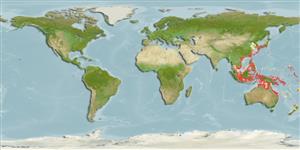Common names from other countries
Environment: milieu / climate zone / depth range / distribution range
Ecologia
marinhas associadas(os) a recifes; intervalo de profundidade 10 - 40 m (Ref. 90102). Subtropical
Indo-West Pacific: southern Japan to Queensland and Western Australia.
Tamanho / Peso / Idade
Maturity: Lm ? range ? - ? cm
Max length : 11.0 cm TL macho/indeterminado; (Ref. 42740)
Espinhos dorsais (total) : 5; Raios dorsais (total) : 20 - 21; Espinhos anais: 1 - 16; Raios anais : 18. This species is characterized by the following: D V,20-21 (usually 21); A I,16-18; 13-15 (rarely 13, usually 14) pectoral rays; 38-43 lateral-line scales; about 2-4 + 7-10 gill rakers; about 4 predorsal scales; ctenoid scales on cheek, in 4 horizontal rows; front of lower jaw with 8 canine teeth; vomerine teeth a broad chevron-shaped patch; with palatine teeth; upper edge of subopercle with a prominent sharp spine; serrae on opercular bones absent; body depth 4.15-4.75 in SL (21.20-24.1% SL); middle dorsal spine longest; membrane from last dorsal spine joined near base of first soft ray; body gray to reddish dorsally, white below with the edges of scales gray; a series of f5 broadly U-shaped dark brown bars on back, smaller posteriorly, or with a series of 5 double dark brown to black dashes, the anterior 2 with 1 above and 1 below lateral line; a series of 9 spots or short bars on lower side of body that may be blackish, reddish, or dusky yellow; small dark reddish spots, one per scale, often present scattered along side of body and on cheek; presence at side of snout of an iridescent pale blue line, and one beneath eye; lips with large dark blotches; usually presence of a midventral blackish spot on isthmus, often with a smaller black spot to each side anteriorly; edge of chin below lower lip dusky to blackish; spinous portion of dorsal fin may be entirely black, but usually blackish with large pale yellowish blotches in outer part; soft dorsal fin with rows of black to black-edged orange spots, the base of most rays black or with black upper ends of U-shaped marks extending into base of fin; anal fin base with a row of red spots, a red submarginal line, and a small black spot on penultimate membrane about one-third distance to margin; caudal fin with small blackish, dusky orange, or red spots, often with smaller white spots as well (Ref. 57562).
Found in silty sand and rubble areas near reefs at depths of 10-40 m (Ref. 2334, 90102).
Ciclo de vida ou comportamento de acasalamento
Maturities | Reprodução | Spawnings | Egg(s) | Fecundities | Larvas
Pelagic spawner. A monandric species though some small males may develop directly from juveniles indicicating diandry (Ref. 103751).
Randall, J.E., G.R. Allen and R.C. Steene, 1990. Fishes of the Great Barrier Reef and Coral Sea. University of Hawaii Press, Honolulu, Hawaii. 506 p. (Ref. 2334)
Status na Lista Vermelha da UICN (Ref. 130435)
CITES (Ref. 128078)
Not Evaluated
Ameaça para os humanos
Harmless
Uso pelos humanos
Ferramentas
Relatórios especiais
Baixar XML
Fontes da internet
Estimates based on models
Preferred temperature (Ref.
115969): 20.5 - 29, mean 27.7 (based on 326 cells).
Índice de diversidade filogenética (Ref.
82804): PD
50 = 0.5000 [Uniqueness, from 0.5 = low to 2.0 = high].
Bayesian length-weight: a=0.00692 (0.00311 - 0.01538), b=3.06 (2.88 - 3.24), in cm Total Length, based on LWR estimates for this Genus-body shape (Ref.
93245).
Nível Trófico (Ref.
69278): 3.4 ±0.4 se; based on size and trophs of closest relatives
Resiliência (Ref.
120179): Elevada, tempo mínimo de duplicação da população menor que 15 meses (Preliminary K or Fecundity.).
Fishing Vulnerability (Ref.
59153): Low vulnerability (10 of 100).
